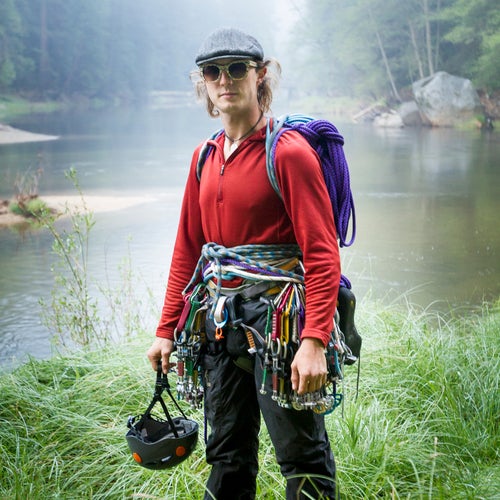The Free Soloist Who Fell to Earth
Austin Howell soloed harder and more often than almost anyone else in the country, documenting his exploits on Instagram and a podcast. But behind the scenes his mental health was faltering.
New perk: Easily find new routes and hidden gems, upcoming running events, and more near you. Your weekly Local Running Newsletter has everything you need to lace up! .
The footage is shaky, but there’s no doubt what’s in the frame: a man��climbing a section of shining white rock. “What in the world,” the guy filming says. “This guy’s fucking insane. He’s soloing, climbing this route, naked, without a rope. He’s out of his damn mind.”
As the camera zooms out, it becomes clear��that the soloist is hundreds of feet off the deck. Aside from eschewing clothes and a rope, the climber is also barefoot. All he’s got on is a gray newsboy cap.��A twangy guitar lick comes in, followed by the lyrics: You can’t kill me / I will not die / Not now, not ever / No never/ I’m gonna live a long, long time / My soul raves on forever.
The clip, just 1 minute 56 seconds��long, ends with a still frame of the climber looking back at the camera and flipping the bird.
Titled “,” the video enjoyed a viral moment in the climbing corners of the internet when its subject, Austin Howell, shared it on Vimeo in April 2015. Howell, then 27, was a sinewy string bean with a permanent dirtbag scruff of a beard. His frizzy shoulder-length locks and the hat, which he was rarely without, belied the quickly thinning hair atop his head.
I remember seeing the clip when it came out. I’d been climbing for five years and was then preparing to take a crack at the 3,000-foot Nose route on El Capitan in Yosemite. I��was blown away by the absurdity of the video, which struck me as��one part Free Solo, one part Jackass. But I was also unsettled, filled with a kind of macabre awe. I began following Howell on Instagram, where he went by .
Howell was an enigmatic character, and I found it difficult to look away from his antics. His death-defying behavior was complemented by a fun-loving temperament. When he went out soloing, for example, he kept mini Snickers in his puppy-dog-shaped chalk bag. If he came upon a roped party, he’d toss a candy bar in their direction.
I followed along as he soloed 19 different 5.12’s, a grade that many people spend their lives trying to climb with a rope on. Many of the routes were in Kentucky’s Red River Gorge and had little margin for error—an overhanging 5.12 could be as steep as the underside of a church dome; a vertical 5.12 might have grips the width of a dime’s edge. One time he free-soloed over a mile of technical��terrain in a single day. The number of people in the world soloing that volume at that difficulty can likely be counted on one hand.
Howell saw his free soloing as the product of careful, sober analysis. He spent hours ahead of each hard climb satisfying what he called his “preflight checklist,” making sure he’d accounted and planned for all the variables that could go wrong. But the annals of climbing, like other extreme sports, are littered with stories of risk-takers who convinced themselves that they could reason their way out of catastrophe.








